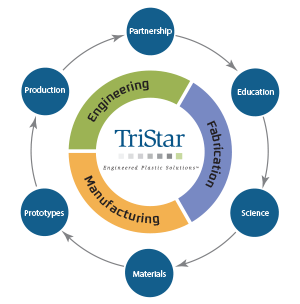
Engineering a Unique Seal to Contain Micro-Meteor Damage on the International Space Station
As the International Space Station (ISS) approaches its final decade in orbit, we’re thinking about some of the interesting projects we have been privileged to be involved with over the years. These include a range of onboard scientific experiments ─ including specially plasma-treated polymer containers used to grow vegetables more efficiently in space ─ as well as components for recovery systems that recycle urine and sweat back into potable water. Today, we will explore a sealing tool we worked on aimed at mitigating environmental damage to the ISS's critical external components.
A Specialized Seal to Repair Micro-Meteor Damage to the Station’s Active Thermal Control System

This project was early in the life of the space station, where NASA and Boeing Space Systems were trying to develop a rapid deployment tool to repair micro-meteor damage. The Active Thermal Control System (ATCS) pumps ammonia through a piping system which helps remove heat from the solar panels and keeps the station temperature under control. The tubular structure has surprisingly thin walls and a micro-meteor strike can cause a leak of ammonia that has to be handled urgently until final repairs can be completed.
Boeing engineers were trying to develop a tool that could seal the leak quickly and efficiently and be easy to deploy. They came up with clamshell device that would snap over the location of the leak but after several “soft” seal devices they couldn’t get anything to pass the helium leak test. Enter TriStar!
Sealing in Extreme Vacuum Conditions Required Careful Material Selection and Precise Dialing-In of Material Properties
The test criteria were challenging, as the seal had to hold helium in vacuum environment at 10-7 Torr and temperatures from -250°F to +250°F. Tests with various polymers and elastomers had failed so TriStar engineers started from scratch with a modified fluoropolymer best known for its cryogenic capabilities as a seal. This material can be manipulated during processing to change the crystalline structure of the polymer through quenching.
We started with a reference point of 60% crystalline and did OK but the seal didn’t completely stop the helium. We went to the lowest amorphous state possible ─ 50% ─ and successfully sealed, but the high temperature test caused more deformation than we wanted. We then began to increase the crystallinity in 1/2% increments until we got a 100% seal of the helium, in vacuum, across the temperature spectrum in ammonia. Success!
Boeing engineers then decided they wanted to see how far they could go with the seal and were able to successfully seal the helium at 10-9 Torr ─ which surprised the Boeing team and NASA as well.
TriStar's Expert Engineering Solutions: Tackling Challenges Across Industries Since 1982
TriStar’s engineers have engaged with many challenging applications over the past 4 decades in industries ranging from aerospace to food production. Whether it’s self-lubricating bearings, difficult sealing problems or composite components for extremely high load conditions, TriStar can help you find a solution to your most difficult problems. As always, we encourage you to reach out to our team to discuss your applications.









